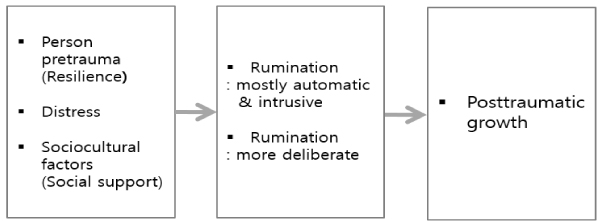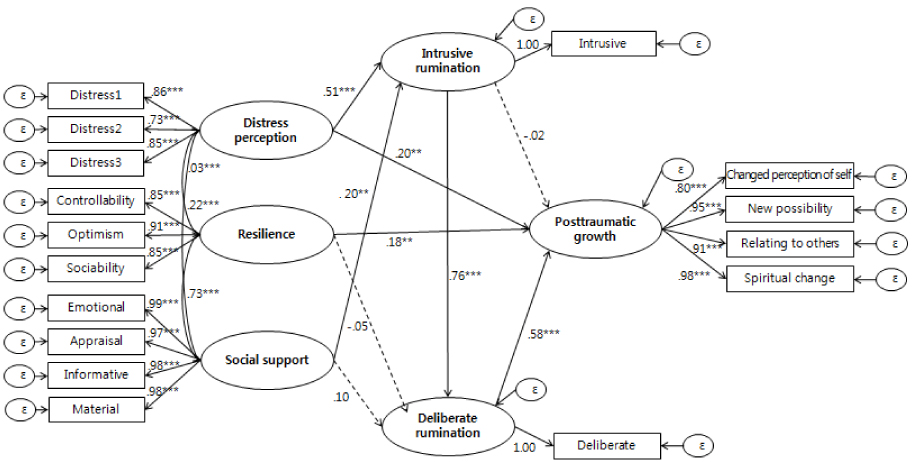J Korean Acad Community Health Nurs.
2019 Sep;30(3):345-356. 10.12799/jkachn.2019.30.3.345.
A Structural Equation Model of Factors Influencing Posttraumatic Growth of Earthquake Victims
- Affiliations
-
- 1Assistant Professor, Department of Nursing, Kyungsung University, Busan, Korea. mykwak@ks.ac.kr
- KMID: 2459373
- DOI: http://doi.org/10.12799/jkachn.2019.30.3.345
Abstract
- PURPOSE
The purpose of this study is to construct and test a structural equation model of posttraumatic growth (PTG) of earthquake victims based on Tedeschi and Calhoun's model (2004).
METHODS
Data were collected from 195 earthquake victims living in K. City. The exogenous variables include distress perception, resilience, and social support, and the endogenous variables include intrusive rumination, deliberate rumination, and posttraumatic growth. For data analysis, descriptive statistics, factor analysis, and structural equation modeling were performed.
RESULTS
The modified model showed a good fitness to the data. Moreover, 6 of the 9 paths of the final model were statistically significant, which include PTG affected by deliberate rumination (β=.58, p<.001), resilience (γ=.18, p=.001), and distress perception (γ=.20, p=.002). These predictors explain 51.8% of variance in posttraumatic growth.
CONCLUSION
Based on the results of this study, it is necessary to develop and disseminate preventive intervention programs to increase the resilience of earthquake-prone communities. In addition, after exposure to a community-scale traumatic event such as earthquake, we should provide social supports to alleviate distress perception and transition from intrusive rumination to deliberate rumination so that we can seek new meaning from the earthquake and facilitate posttraumatic growth.
Keyword
Figure
Reference
-
1. Yoo MR, Choi SY, Han HL, Seo YM, Noh MI. The effect of post-traumatic growth, resilience, and optimism on quality of life among the disaster Victims. Journal of Military Nursing Research. 2015; 33(2):1–14.
Article2. Uemura M, Ohira T, Yasumura S, Otsuru A, Maeda M, Harigane M, et al. Association between psychological distress and dietary intake among evacuees after the Great East Japan Earthquake in a cross-sectional study: The Fukushima Health Management Survey. BMJ Open. 2016; 6(7):e011534. DOI: 10.1136/bmjopen-2016-011534.
Article3. Choi NH, Byun JH, Han DI, IM SB. Psychological impact and depressive response of sufferers of natural disaster, a torrential downpour. Journal of Korean Academy of Psychiatric and Mental Health Nursing. 2007; 16(2):139–149.4. Korea Meteorological Administration. 2016 Seismological annual report [Internet]. Seoul: Korea Meteorological Administration;2017. cited 2017 october 16. Available from: http://web.kma.go.kr/notify/press/kma_list.jsp?bid=press&mode=view&num=1193318.5. Kim YH. A multi-dimensional approach to disaster mental health and the roles and contributions of social work field. Korean Journal of Social Welfare Studies. 2011; 42(4):5–34.6. Alderman K, Turner LR, Tong , S . Assessment of the health impacts of the 2011 summer floods in Brisbane. Disaster Medicine and Public Health Preparedness. 2013; 7(4):380–386. DOI: 10.1017/dmp.2013.42.
Article7. Goto T, Wilson JP, Kahana B, Slane S. The Miyake Island volcano disaster in Japan: Loss, uncertainty, and relocation as predictors of PTSD and depression. Journal of Applied Social Psychology. 2006; 36(8):2001–2026. DOI: 10.1111/j.0021-9029.2006.00091.x.
Article8. Song SS, Kim KH, Kwon SJ, Lee HS. Reliability and validity of a Korean version of the posttraumatic growth inventory. In : 2006 Annual Conference of Korean Psychological Association; 2006 August 18–19; Seoul National University. Seoul: Korean Journal of Psychology;2006. 08. p. 695.9. Kwak M, Bae J. Posttraumatic growth and related factors in firefighters. Journal of Korean Academy of Psychiatric and Mental Health Nursing. 2017; 26(2):124–133. DOI: 10.12934/jkpmhn.2017.26.2.124.
Article10. Calhoun LG, Tedeschi RG. Target article: “Posttraumatic growth: Conceptual foundations and empirical evidence”. Psychological Inquiry: An International Journal for the Advancement of Psychological Theory. 2004; 15(1):1–18. DOI: 10.1207/s15327965pli1501_01.11. Kim MY. Posttraumatic growth characteristics and distress in mothers of children with cancer. Asian Oncology Nursing. 2015; 15(4):239–245.
Article12. Kim BR, Shin HC. The influence of ego-resilience and meaning in life on posttraumatic growth: Mediating effect of searching for meaning and presence of meaning. Korean Journal of Psychology: General. 2010; 22(1):117–136.13. Kim MY, Kim KS. Influence of hope, core beliefs and social support on posttraumatic growth in mothers of chronically ill children. Journal of Korean Academy of Fundamentals of Nursing. 2012; 19(4):493–502.
Article14. Choi SM. Exploration of posttraumatic growth related variables [dissertation]. Seoul: Korea University;2008. 107.15. Han YM. The influence of ego resilience on post-traumatic growth in single men and women who have experienced dating relationship breakup [master's thesis]. Seoul: Myongji University;2015. 1–69.16. Bellizzi KM, Blank TO. Predicting posttraumatic growth in breast cancer survivors. Health Psychology. 2006; 25(1):47–56. DOI: 10.1037/0278-6133.25.1.47.
Article17. Cann A, Calhoun LG, Tedeschi RG, Vishnevsky T, Lindstrom CM. Assessing posttraumatic cognitive processes: The event related rumination inventory. Anxiety, Stress, and Coping. 2011; 24(2):137–156. DOI: 10.1080/10615806.2010.529901.
Article18. Linley PA, Joseph S. Positive change following trauma and adversity: A review. Journal of Traumatic Stress. 2004; 17(1):11–21.
Article19. Kim YA, Choi YK. A qualitative study for the process of posttraumatic growth-a comparison of trauma survivors‘and therapists' perspective. Korean Journal of Health Psychology. 2017; 22(1):199–228.20. Yoon MS, Park EA. Posttraumatic growth among mental health social workers. Mental Health & Social Work. 2011; 39:61–89.21. Lee S, Kim YJ. Posttraumatic growth of patients with breast cancer. Journal of Korean Academy of Nursing. 2012; 42(6):907–915. DOI: 10.4040/jkan.2012.42.6.907.
Article22. Shin SY, Jeong NW. The effect of meaning in life and social support on posttraumatic growth. Journal of Human Understanding and Counseling. 2012; 33(2):217–235.23. Yu HJ. The mediating effect of social support and deliberate rumination in the influence of resilience and distress perception on posttraumatic growth. Korean Journal of Counseling. 2014; 15(1):59–85.24. Yu JP. The concept and understanding of structural equation modeling. Seoul: Hannarae Publishing Co.;2012. p. 567.25. Shin WY, Kim MG, Kim JH. Developing measures of resilience for Korean adolescents and testing cross, convergent, and discriminant validity. Studies on Korean Youth. 2009; 20(4):105–131.26. Park JW. A study to development a scale of social support [dissertation]. Seoul: Yonsei University;1985. 127.27. Ahn HH, Joo HS, Sim KS, Min JW. Validation of the event related rumination inventory in a Korean population. Cognitive Behavior Therapy in Korea. 2013; 13(1):839–854.28. Calhoun LG, Tedeschi RG. The posttraumatic growth inventory: Measuring the positive legacy of trauma. Journal of Traumatic Stress. 1996; 9(3):455–471. DOI: 10.1002/jts.2490090305.29. Eun HJ, Lee SM, Kim TH. The epidemiological study of posttraumatic stress disorder in an urban area. Journal of Korean Neuropsychiatric Association. 2001; 40(4):581–591.30. Kim HS, Nam CY, Lee HJ. Effects of post traumatic growth of firefighters-focused on the D-city fire official. Korean Review of Crisis and Emergency Management. 2014; 10(10):103–121.
- Full Text Links
- Actions
-
Cited
- CITED
-
- Close
- Share
- Similar articles
-
- The Structural Equation Model for Posttraumatic Growth of Firefighter: Based on the Calhoun and Tedeschi's model of posttraumatic growth
- The Structural Analysis of Variables Related to Posttraumatic Growth among Psychiatric Nurses
- Model Setting and Interpretation of Results in Research Using Structural Equation Modeling: A Checklist with Guiding Questions for Reporting
- Structural Equation Model for Psychosocial Adjustment of Breast Cancer Survivors Based on Family Resilience Model
- A Structural Equation Model for Posttraumatic Growth among Cured Patients with COVID-19



